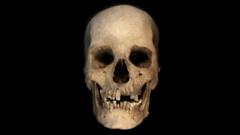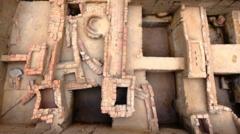Groundbreaking DNA tests on a skeleton from the Nile Valley have uncovered evidence of ancient migration between Egypt and Mesopotamia, suggesting cultural exchanges that contributed to the rise of these civilizations around 4,500 years ago.
DNA Findings Challenge Understanding of Ancient Egyptian Civilisation

DNA Findings Challenge Understanding of Ancient Egyptian Civilisation
A recent DNA analysis of a 4,500-year-old skeleton has revealed new insights into the connections between Ancient Egypt and Mesopotamia, potentially reshaping historical narratives.
A recent study conducted on the remains of a man who lived 4,500 years ago in the Nile Valley has revolutionized our understanding of the connections between ancient Egypt and Mesopotamia. The individual, who was likely a potter and lived to the age of 60, had a surprising amount of genetic material—about 20%—derived from ancestors located 1,500 kilometers away in present-day Iraq. This DNA discovery serves as the first tangible evidence of migration and interaction between these two significant civilizations during a pivotal era.
The findings of this research, published in the journal Nature, support the theory that the two regions were not isolated but rather experienced significant cultural and demographic exchanges. Professor Pontus Skoglund from the Francis Crick Institute emphasized the importance of combining DNA evidence with archaeological and written records, as it provides a more nuanced view of ancient societies beyond the narratives created by the elite.
The subject of this study had been buried in a ceramic pottery coffin in Nuwayrat, located 265 kilometers south of Cairo. The analysis of his remains identified him as predominantly Egyptian in origin but also highlighted connections to the Fertile Crescent. This indicates that contact and communication between Egypt and Mesopotamia may have existed at least 10,000 years ago, facilitating the transfer of agricultural practices and writing systems that were emerging in both regions around this period.
Adeline Morez Jacobs, who participated in the analysis as part of her PhD, indicated that this discovery illustrates the cross-cultural links that fostered the growth of two of history’s mightiest civilizations. The soldier's burial before artificial mummification was commonplace might have played a role in preserving his DNA for subsequent study.
Joel Irish, another researcher involved, sought to paint a detailed picture of the man’s life, revealing his stature, profession, and personal struggles, including signs of physical labor that suggest he had a rigorous, industrious life. His skeletal characteristics point towards someone used to heavy lifting and hard surfaces, reinforcing the image of a hardworking craftsman.
Furthermore, the skeleton’s survival through historical adversities, including World War II bombings that destroyed much of the collection to which it belonged, highlights the serendipitous nature of historical preservation.
As researchers continue to analyze ancient DNA, hopes grow that they will unlock further mysteries of historical movements and social dynamics between these two ancient civilizations, offering profound insights into humanity's shared past.

















